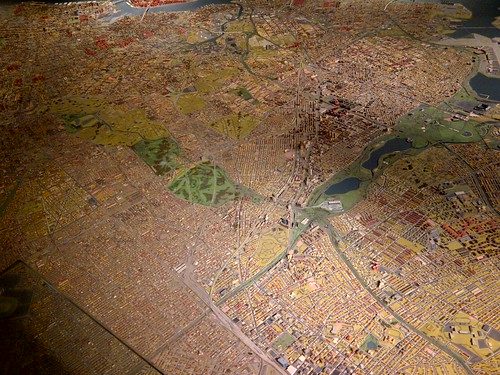Works & Process at the Guggenheim is a performing arts series that explores artistic creation through conversation and performance. Performances take place in the Guggenheim Museum’s Peter B. Lewis Theater, which was also designed by Frank Lloyd Wright. The theater has a strange layout. The orchestra sits in a shallow bowl that you walk down into – if you’re sitting in the last outside seat of a row, like I was, you are on the side of the bowl and leaning in the entire time. There’s a wide space on the floor level between the orchestra section and the ‘balcony.’ On the left side there is a row of seats against the wall. On the right side there is the row of seats against a wall and then steps up into more seats. It is a low stage, so the heads in front of me sometimes blocked me being able to see the dancers’ feet.
The Joyce Theater was working with Works & Process to present the Malpaso Dance Company from Cuba. The company will be dancing at the Joyce in May and if you can get a ticket, I urge you to go.
First the company performed Under Fire. Choreography is by Trey McIntyre, lighting design was by Al Crawford, and costume design by Reid Bartelme. The dancers were Dunia Acosta, Maria Karla Araujo, Randy Cívico, Osnel Delgado (artistic director and co-founder), Manuel Durán, Beatriz Garcia, Taimy Miranda, and Joan Rodríguez. The music by Grandma Kelsey was just her voice and an acoustic guitar (on tape). She sounded a little like Rickie Lee Jones and someone else who I can’t quite place. McIntyre was moving forward, leaving his traditional company and pursuing individual projects, and wanted to burn all his paper, which had become a “weight and a burden.” Moving the charred paper with a stick, after the fire had gone out, McIntyre found that what was underneath was “pristine.” “In some ways the fire had compacted it, sealed it, made it more of what it is.” McIntyre saw this as a metaphor for human life – “The more we try to burn away and change our exterior, the more our essential born selves become evident and manifest.”
The men were dressed in black shirts with different types of sleeves and black pants. The women wore black sheer fabric overlaid different colors and different types of clothing – skirts, unitards, and culottes. All wore black shoes. The company starts with them all on stage and then they peel off. Couples come back and dance together and then separate and run offstage. There was one duet to “Jolene” that was my favorite. Arms and legs slice up and down but never interfere and never are in the way.
Intermission was a discussion with Linda Shelton (executive director, Joyce Theater), Fernando Sáez (executive director and co-founder, Malpaso Dance Company), McIntyre, and Arcell Cabuag (associate artistic director, Evidence – A Dance Company). Cabaug was the assistant choreographer working with Ronald K. Brown (choreographer) on the piece coming after intermission. Sáez said the name (means misstep in English) came about because they wanted to be humble. The founders (which also includes Daileidys Carrazana) left the national ballet company to form their company. Brown chose Malpaso out of a lot of companies for his commission from the Joyce. Cabuag said that Cuba has a rich history of dance – as soon as the music starts playing the kids start dancing. McIntyre also loves Cuba. Asked about the lifting of the embargo, Sáez said that the company was rehearsing with Arturo O’Farrill and his orchestra when they heard about it. O’Farrill was in the audience sitting right behind me. No one knew how the exchange that was already happening would be affected by the embargo lift.
The final dance was Why You Follow. The pieces are “Open Heart,” “Commitment,” “The Path,” and “Faithfully Forward.” Music was “Looklat Africa” by Zap Mama, “En route to Motherland” by Gordheaven & Juliano, “Yoruba Road” by The Allenko Brotherhood, and “Kusase Mnandi” by Gordheaven & Juliano and The Heavy Quarterz. Lighting was by Clifton Taylor and costumes by Keiko Voltaire. Dancers were Acosta, Araujo, Carrazana, Cívico, Delgado, Durán, Miranda, and Rodríguez. The dancers were barefoot and dressed street casual. The moves were a blend of Afro-Cuban and modern. Cabuag had said how much Brown loved Afro-Cuban dancing and how he liked working with the Cuban dancers. When the entire company was on stage and couples were mirroring each other, I actually felt that they were dancing in front of mirrors because the moves were so in sync.
Not a single misstep.
After they took their bow, the dancers continued dancing on stage and the audience clapped along.
Upstairs in the lobby, there was a reception with sandwiches, cookies, chips, and wine. Since I’d gotten a promo code for the ticket, I got the entire wonderful evening for only $25.
By Carene Lydia Lopez

